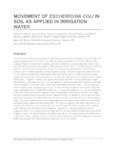Use este identificador para citar ou linkar para este item:
http://www.alice.cnptia.embrapa.br/alice/handle/doc/970550| Título: | Movement of Escherichia coli in soil as applied in irrigation water. |
| Autoria: | SHOCK, C. C.  PINTO, J. M.   LAUBACHER, T. A.   ROSS, R. D.   MAHONY, A. C.   KREEFT, H.   SHOCK, B. M.   |
| Afiliação: | JOSE MARIA PINTO, CPATSA. |
| Ano de publicação: | 2013 |
| Referência: | In: SHOCK, C. C. (Ed.). Preliminary studies on Escherichia coli and onion. Ontário: Oregon State University, Malheur Experiment Station, 2013. |
| Páginas: | p. 1-17. |
| Conteúdo: | The US Food and Drug Administration (FDA) has proposed that If irrigation water exceeds 235 colony-forming units (CFU) of E. coli /100 ml in any one sample or 126 CFU/100 ml in the average of any five consecutive samples, growers would have to cease using that water in any way that directly contacts the surface of fresh produce (FDA 2013). The FDA has proposed that these E. coli levels are an indication of high risk of bacterial contamination of fresh onion (Allium cepa L.) bulbs regardless of the irrigation system. If onion irrigation exceeds 235 CFU, it is not known whether the contaminated water applied by furrow or drip irrigation actually reaches the onion bulb. Soil could filter E. coli and other bacteria before irrigation water reaches onion bulbs. ?Vaquero? onions were grown on Owyhee silt loam. In our preliminary studies reported here, well water free of E. coli was applied to onions through drip irrigation or through furrow irrigation. A second water source was intentionally enriched with E. coli by being run across a pasture and recaptured prior to use. Furrow and drip irrigation were used to apply this water containing 218 to >2400 MPN/100ml for 11+ hours per irrigation. E. coli was monitored in the soil water at the end of irrigation cycles through direct sampling of the soil. Soil water was also sampled using sterile soil solution capsules (SSSC) to sample E. coli in the soil water that moved into place, to differentiate the movement of soil water from the soil water already in place. Soil water measurements were made adjacent to the water source, half way to the bulbs, and immediately adjacent to the onion bulbs. For furrow irrigation with ditch water the E. coli counts in the soil next to the onion bulbs was only 0% and 21% of the counts in the irrigation water following the first and second irrigations, respectively. During subsequent furrow irrigations, the E. coli counts in the soil water next to the onion bulbs exceeded the counts in the irrigation water. For drip irrigation with ditch water, the E. coli counts in the soil solution next to the onion bulbs remained very low. The soil water sampled by the SSSC adjacent to the onion bulbs drip-irrigated with ditch water also had very low E. coli counts. |
| Thesagro: | Cebola Irrigação Água Allium Cepa Bactéria Escherichia Coli |
| Palavras-chave: | Onion |
| Série: | (OSU. Special Report, Ext/CrS, 148). |
| Tipo do material: | Parte de livro |
| Acesso: | openAccess |
| Aparece nas coleções: | Capítulo em livro científico (CPATSA)  |
Arquivos associados a este item:
| Arquivo | Descrição | Tamanho | Formato | |
|---|---|---|---|---|
| Pinto1.pdf | 727,59 kB | Adobe PDF |  Visualizar/Abrir |









